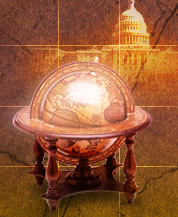 |
||
  |
||
|
|

|
||
World History - Human Rights: Lesson Plans
| Argument in an Athenian Jail: Socrates and the Law
Debate the relationship between individual rights and the rule of law with a philosopher condemned to death.
|
| Cultural Change
See how the rhetoric of women’s rights evolved from the “Declaration of Sentiments” of 1848 to the suffragist arguments that finally prevailed.
|
| Declare the Causes: The Declaration of Independence
Help your students see the development of the Declaration as both an historical process and a writing process through the use of role play and creative writing.
|
| Families in Bondage
Learn how slavery shattered family life through the pre-Civil War letters of those whose loved ones were taken away or left behind.
|
| Freedom by the Fireside: The Legacy of FDR's “Four Freedoms” Speech
One of the most famous political speeches on freedom in the twentieth century was delivered by Franklin Delano Roosevelt in his 1941 State of the Union message to Congress.This lesson examines some of the nuances and ambiguities inherent in the rhetorical use of "freedom." The objective is to encourage students to glimpse the broad range of hopes and aspirations that are expressed in the call of—and for—freedom.
|
| Holocaust and Resistance
In this lesson, students reflect on the Holocaust from the point of view of those who actively resisted Nazi persecution. Weigh the choices faced by those for whom resistance seemed both futile and the essence of survival.
|
| Live From Antiquity!
Return to ancient Athens for the world premier of Antigone. This is the revised and updated version of the lesson plan.
|
| Martin Luther King, Jr., and the Power of Nonviolence
Students learn about Martin Luther King, Jr.'s philosophy of nonviolence and the teachings of Mohandas K. Gandhi that influenced King's views.
|
| Norman Rockwell, Freedom of Speech—Know It When You See It
This lesson plan highlights the importance of First Amendment rights by examining Norman Rockwell’s painting of The Four Freedoms. Students discover the First Amendment in action as they explore their own community and country through newspapers, art, and role playing.
|
| Perspective on the Slave Narrative
Trace the elements of history, literature, polemic, and autobiography in the 1847 Narrative of William W. Brown, An American Slave. This Lesson Plan was revised 01/19/2006
|
| Regulating Freedom of Speech
With the Internet, students can observe firsthand how today's
Court exercises this responsibility at a time when technology
has extended the freedom to speak in ways our nation's founders
could not have imagined.
|
| Scripting the Past: Exploring Women's History Through Film
Students employ the screenwriter's craft to gain a fresh perspective on notable women in American history.
|
| Slave Narratives: Constructing U.S. History Through Analyzing Primary Sources
The realities of slavery and Reconstruction hit home in poignant oral histories from the Library of Congress. In these activities, students research narratives from the Federal Writers' Project and describe the lives of former African slaves in the U.S. -- both before and after emancipation. From varied stories, students sample the breadth of individual experiences, make generalizations about the effects of slavery and Reconstruction on African Americans, and evaluate primary source documents.
|
| Spirituals
Tap into an African-American song tradition that has fired hope throughout the long struggle for freedom.
|
| The Emancipation Proclamation: Freedom's First Steps
(Formerly titled "Attitudes Toward Emancipation"). Why was the Emancipation Proclamation important? While the Civil War began as a war to restore the Union, not to end slavery, by 1862 President Abraham Lincoln came to believe that he could save the Union only by broadening the goals of the war. Students can explore the obstacles and alternatives America faced in making the journey toward "a more perfect Union."
|
| The Industrial Age in America: Robber Barons and Captains of Industry
How shall we judge the contributions to American society of the great financiers and industrialists at the end of the nineteenth and beginning of the twentieth centuries? In this lesson, students explore a variety of primary historical sources to uncover some of the less honorable deeds as well as the shrewd business moves and highly charitable acts of the great industrialists and financiers, men such as Andrew Carnegie, J. Pierpont Morgan, John D. Rockefeller, and Cornelius Vanderbilt.
|
| The Industrial Age in America: Sweatshops, Steel Mills, and Factories
About a century has passed since the events at the center of this lesson-the Haymarket Affair, the Homestead Strike, and the Triangle Shirtwaist Factory Fire. In this lesson, students use primary historical sources to explore some of the questions raised by these events, questions that continue to be relevant in debates about American society: Where do we draw the line between acceptable business practices and unacceptable working conditions? Can an industrial-and indeed a post-industrial-economy succeed without taking advantage of those who do the work?
|
| Who Was Cinque?
Meet the leader of the Amistad revolt through contemporary news reports, court records, and illustrations.
|
  |
||
| EDSITEment contains a variety of links to other websites and references to resources available through government, nonprofit, and commercial entities. These links and references are provided solely for informational purposes and the convenience of the user. Their inclusion does not constitute an endorsement. For more information, please click the Disclaimer icon. | ||
| Disclaimer | Conditions of Use | Privacy Policy Search
| Site
Map | Contact
Us | ||
